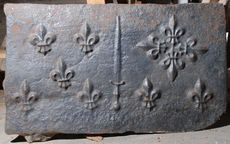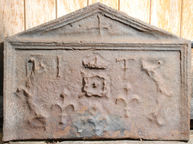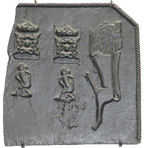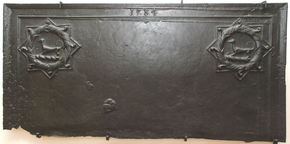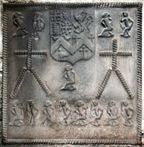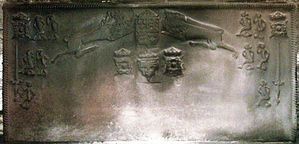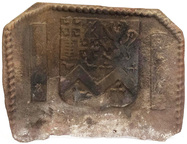-
660
Description: Rectangular; plain plate; central, vertical cross-hilt dagger stamp; left side, fleur de lys stamp repeated five times, irregularly arranged in three rows, two above and below and one in the middle; right side, fleur de lys stamp repeated six times, four in a star above two in a row.
Notes: The dagger (length approx. 35cm), seen on two other firebacks (no. 595 and no. 1100), may have beeen of Italian manufacture. The form of the fleurs-de-lys identifies this fireback as one of the ‘Royal’ series, a large group bearing heraldic stamps.
- Decoration tags:
- rectangular (shape)
- none (edging)
- simple stamps
- carved stamps
- heraldic
- objects
Manufactured: in the mid-16th century in the Weald area of England.
Current location: Hole Park, Rolvenden, Kent, England.
- Attached to series:
- Knife & Dagger stamp firebacks
- Royal series
- Fleur-de-lys firebacks
-
689
Description: Rectangular with pediment; ovolo moulded edging inside top of pediment and inside top and sides of rectangle; centre top, four-petal rose and crown with three fleurs-de-lys below; at either end, stamps made from two parts of a wreath (the middle section missing); in the pediment a cross.
Notes: The wreaths from which the stamps have been disassembled can be seen complete on two other firebacks, and the rose and crown is a common stamp on a large series of early firebacks.
Inscription: I T
- Decoration tags:
- triangular arched (shape)
- cavetto (edging)
- carved stamps
- individual letters
- heraldic
- royal
- text
- objects
Manufactured: in the late-16th century in the Weald area of England.
Current location: in private hands, Slaugham, West Sussex, England.
- Attached to series:
- Royal series
- Royal (wreath) series
- Fleur-de-lys firebacks
-
1094
Description: Rectangular; twisted rope edging (top and sides); top centre, crowned Tudor royal shield between a lion passant on the right and a lion passant guardant sinister on the left; in each top corner a crowned four-petal rose, below which, to the right, a left-facing 'imp' with both arms lowered; below the armorial, a crowned shield bearing initials, KH, in Lombardic lettering, above a fleur-de-lys; a much-corroded imp figure may be below the right-hand lion.
Notes: A heavily corroded variant of a type bearing Henrician heraldic elements.
Arms: Tudor royal arms of England
- Decoration tags:
- rectangular (shape)
- rope (edging)
- carved stamps
- heraldic
- armorial
- animals
- humans
Manufactured: in the mid-16th century in the Weald area of England.
Current location: Smallhythe Place, Small Hythe Road, Tenterden, Kent, England.
Museum number: 1117950 (part of the National Trust museum group)
- Attached to series:
- Royal series
-
748
Description: Fragment; right part only; canted rectangle; twisted rope edging; lion passant positioned vertically along right side; rose and crown stamp repeated twice (both over-pressed), each above an ‘imp’ figure with both arms lowered.
Notes: A particularly clear casting; the right rear leg of the lion (missing on some variants of this series) has been replaced by a short length of twisted rope.
- Decoration tags:
- rectangular with canted top corners (shape)
- rope (edging)
- carved stamps
- heraldic
- animals
Manufactured: in the mid-16th century in the Weald area of England.
Current location: Victoria & Albert Museum, Cromwell Road, Kensington & Chelsea, Greater London, England.
Museum number: 897.1901 (part of the Victoria & Albert Museum museum group)
- Attached to series:
- Royal series
-
752
Description: Rectangular; cavetto moulded edging on top and sides, with astragal and fillet inside; talbot crest within wreath and eight-pointed star, repeated at top corners; date top centre between mouldings.
Notes: The crest is probably that of the Parker family, of Ratton, near Eastbourne, Sussex. The base board appears to have been repositioned prior to the wreath stamps being impressed in the mould. Acquired from Marle Green Farm, Hellingly, Sussex, in 1896.
Inscription: 1584
- Decoration tags:
- rectangular (shape)
- carved stamps
- individual numbers
- heraldic
- text
- animals
- objects
Manufactured: in 1584 in the Weald area of England.
Current location: Victoria & Albert Museum, Cromwell Road, Kensington & Chelsea, Greater London, England.
Museum number: 780.1896 (part of the Victoria & Albert Museum museum group)
- Attached to series:
- Royal series
- Royal (wreath) series
-
920
Description: Rectangular; twisted rope edging; top centre, quartered shield between four 'imp' figures, left facing, one with right arm raised, one of each on each side; below each pair of figures, a rope cross above an inverted V in rope, with an 'imp' figure, arms lowered, below the shield; along the bottom, eight 'imp' figures, alternately arms raised and lowered.
Notes: The 'imp' figures are common on a group of firebacks, the rope designs having a probable apotropaic significance. The arms are probably of Thomas Wriothesley, who was Henry VIII's last Lord Chancellor and created Earl of Southampton in 1547; he married c.1533 so the arms could date to before then, but the same arms are displayed on his enamelled stall plate in St George's Chapel, Windsor, of 1545, and in stained glass in a window in the parish church at South Warnborough, Hampshire. The shield is, quarterly, 1. Wrythe or Wriothesley quartering Dunstanville and Pink, 2. Drayton, 3. Crocker and 4. Peckham. The same armorial stamp has been noted on at least two other firebacks. A candidate for the earliest English fireback with an example of personal arms.
Arms: Wriothesley (Earl of Southampton)
- Decoration tags:
- rectangular (shape)
- rope (edging)
- simple stamps
- carved stamps
- apotropaic
- armorial
- humans
- objects
Manufactured: in the mid- to late-16th century in the Weald area of England.
Current location: in private hands, Wigmore, Herefordshire, England.
- Attached to series:
- Royal series
- Personal armorial firebacks
- Wriothesley firebacks
-
595
Description: Rectangular; twisted rope edging (top and sides); top centre; crowned Tudor royal shield with angled lion passant guardant sinister to the left, and an angled lion passant to the right; below, a crowned shield with a fleur-de-lys below initials (over-pressed), between two four-petalled, crowned roses; the same crowned rose repeated in each top corner, below each a vertical dagger, point upwards; inside the roses and daggers, two tiered pairs of ‘imp’ figures, one of each with arm raised, above a single figure, its arms lowered.
Notes: Each dagger, which is seen on two other firebacks (no. 660 and no. 1100), is approx. 35cm long.
Copies of this fireback are known.
Inscription: KH
Arms: Tudor royal arms of England
- Decoration tags:
- rectangular (shape)
- rope (edging)
- carved stamps
- heraldic
- armorial
- royal
- animals
- humans
Manufactured: in the mid-16th century in the Weald area of England.
Current location: in private hands, Wigmore, Herefordshire, England.
- Attached to series:
- Royal series
- Knife & Dagger stamp firebacks
-
1305
Description: Quasi-rectangular with canted top corners; twisted rope edging (top and sides); centre top, quartered shield between two vertical carved stamps of a billet with five oval shapes.
Notes: The arms are probably of Thomas Wriothesley, who was Henry VIII's last Lord Chancellor and created Earl of Southampton in 1547; he married c.1533 so the arms could date to before then, but the same arms are displayed on his enamelled stall plate in St George's Chapel, Windsor, of 1545, and in stained glass in a window in the parish church at South Warnborough, Hampshire. The shield is, quarterly, 1. Wrythe or Wriothesley quartering Dunstanville and Pink, 2. Drayton, 3. Crocker and 4. Peckham. A candidate for the earliest English fireback with an example of personal arms. It is possible that this casting is the one formerly at Warnham Court, Sussex, which was illustrated by J. Starkie Gardner in Country Life in 1907. A similar fireback is no. 334. William Smith Auctions, Plainfield, NH, 20 Nov 2024, lot 424 ($250).
Arms: Wriothesley (Earl of Southampton)
- Decoration tags:
- rectangular with canted top corners (shape)
- simple stamps
- carved stamps
- heraldic
- armorial
- objects
Manufactured: in the mid- to late-16th century in the Weald area of England.
Current location: not known.
Citation: Gardner, J. S., 25 May 1907, 'Old Wealden Ironwork at Warnham Court', Country Life, pp. 730-2.
- Attached to series:
- Wriothesley firebacks
- Royal series
- Personal armorial firebacks
